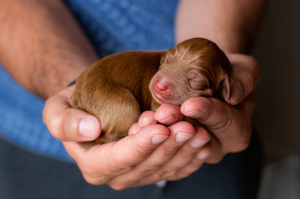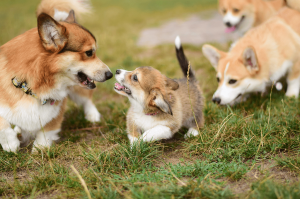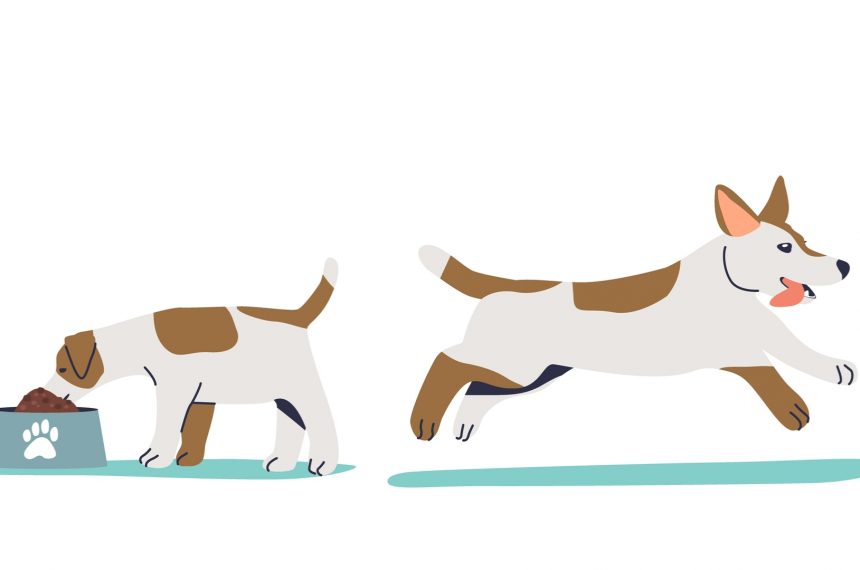The new member of our family can be a puppy. Our friend has different needs in every stage of growth and development. Understanding these stages and needs is the first task of a conscious dog owner.
The monthly development stages of dogs are divided into four:
- “new born period”
- “ge transition period”
- Socialization period, the,
- Ergation periods.
1)The New Born Period (Birth to 2 weeks of age)

New born dogs, in this phase, they live their lives completely dependent on their mother and have almost no contact with the outside world.
They spend most of their time sleeping and the rest of their time eating.
In newborn dogs, the eyes and ears are closed. They do not react in any way. His eyes open after 10 days. Only during this period mother's milk they may be sensitive to it, unable to react to an outside sound or image.
Hearing and vision in newborn dogs lasts about 3 weeks. They do not react to mild warnings during this time.
It is important for dogs to be fed with breast milk from the first 24 hours of their newborn period. In this period “kolostrum” consuming the dense, thick and antibody-rich fluid called is extremely important in terms of gaining resistance to the surrounding pathogenic organisms.
Newborn dogs cannot even carry their own body weight during their first period. In this period healthy eating for breast milk as an extremely important factor directly affects their lives.
IMPORTANT WARNING: Puppies in this period should somehow be separated from their mother, so that the owner is extremely interested in making sure that the dog is comfortable both physically and psychologically.
2)Transition Period (2 to 3 weeks of age)

The transition period in puppies is considered to be the first stage of development of the dog. During the transition period, wheezing, wagging tail and game social behaviors, such as playing, begin to develop.
In the last days of the transition period, puppies begin to recognize the external environment and other living things and begin to respond to incoming reactions.
The fact that behaviors such as sleeping and chewing also begin to develop in this period shows that the transition period is important for puppies.
Again, puppies should not be separated from their mothers because they are attached to their mothers.
3)Socialization Period (from 3 to 12 weeks of age)

For puppies during these periods when they begin to communicate with the outside world “ge transition period” so it will be true.
During this period of behavior changes, acting spirits begin to develop. Don't react to people they've just met, commands reactions such as starting to understand begin to develop in this period.
There are some changes seen during the socialization period in dogs. Among them, predatory actions such as crashing, shaking and following inanimate objects are the most common behaviors.
Dogs in this period biting they also begin to show their actions. For this reason, the period of socialization in terms of development is considered an important stage for dogs.
During the socialization period puppy dog training importance must be given. Because the changes they undergo in this period will have a very important effect in determining the temperament of the dog in the future.
Toilet Training, basic obedience training and command training like Dog Training topics should be given from this period.
Dog training specialists, the beginning of the training of dogs during the socialization period, in the future advanced obedience training he states that challenging trainings, such as more comfortable pass, are quite effective.
IMPORTANT WARNING: The most appropriate stage for people who want to adopt a puppy is the socialization stage. Because at this stage, the puppy can get used to the environment more easily.
However, if it is still the case of acquiring the mother of the dog, it will be better for the development of the dog not to separate it from its mother or to own both.
4)Pregnancy Period (from 12 weeks of age to adulthood)

All the sensory organs of a dog that has reached puberty are actively working. In this period, instead of milk teeth adult the teeth begin to come out. In other words, the period of adolescence can be said as the period when it is fully accepted that the dog is now in the developmental age.
There are similarities in dogs between puberty and the period of socialization. Because in this period, dogs continue to develop and react to the outside world.
Experts say that the socialization training of dogs who have reached puberty should continue.
Because although your dog may look bigger in your eyes during this period, socialization training should be given more strictly because it is not yet an adult dog.
It is also important to train dogs during puberty. Not just socialization training, basic obedience training, such as advanced obedience training and command training Dog training, the,, it will affect the better development of your dog and the stronger communication bond between you.
Nutrition During Adolescence
Puppy feeding during adolescence is different compared to puppy and adulthood. In this period when it starts to develop physically, you should feed your dog with dog diet food and The best dog food it is also important that you choose one of your options.
There are some situations that you should consider when it comes to feeding dogs. These;
- Dog's breed
- Energy requirement
- Determination of the appropriate number of calories.
By acting according to the above mentioned situations, feeding the dog during adolescence directly affects its development and affects its health.
Feeding in dogs during puberty should be proportionate. This ratio, when the puppies reach 50% of the adult body weight, 1.6 times the adult requirement and 80% of the adult body weight, 1.2 times the adult body weight.
Puppy Dog Feeding Schedule According to Development Processes
| From birth to three weeks | During this period, dogs only need to be fed with breast milk. If this is not possible, special milk formulated to the requirements
they should be fed with substitution foods (milk powder). |
| From three weeks to eight weeks of age (milk cutting) | For puppies who continue to absorb breast milk during this period, breast milk should be insufficient or the dog should be allowed to access the appropriate food freely if it is not absorbed. |
| From 8 weeks of age to four months of age | Dogs in this period should be given the first meal in the early morning.Splitting their meals every 16 hours every 4 hours is the most appropriate way of feeding. |
| From four months to six months | Nutrition meals can be reduced to 2 times a day. |
| After six months of age | Adult nutrition should be applied during this period. Two meals a day is enough. |
Is the dog 3 months old?
Experts say that it is appropriate for 16-week-old dogs to be walked outside. So the 3 month old dog can be walked outside. For socialization training, it is more appropriate to give home training to smaller dogs.
How much does a 3 month old dog eat?
It is important to give 3 month old dogs 3 meals a day of puppy food and pay attention to the fact that the food is rich in content.
When do dogs get out of puppyhood?
In general, dogs reach adulthood at 9 months. However, this can sometimes be between 12-24 depending on the breed of the dog.


